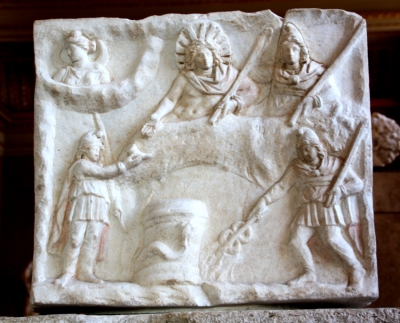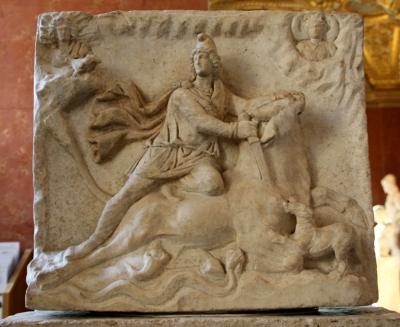Un jour, Une Œuvre,
21/12
Double-Sided Mithraic Relief MND 1911 Denon room 25 Mithra, the Persian god of light, is shown on one side of the relief cutting the throat of a divine bull to make the universe fruitful. On the other side, he is depicted at a banquet with the sun,
to which he is compared.
The Mithra cult and Christmas
Christmas and Bible
The Mithra cult AR83 ‘reveals the unmistakable influence of Babylonian conceptions; and if it be recalled what a degree of importance the mysteries connected with this cult acquired among the Romans, another link will be added connecting the ramifications of ancient culture with the civilization of the Euphrates Valley’ .
This cult is closely associated with the origins of the festival of Christmas. AR84 , AR85
Mithra and Babylonian conceptions ?
“The Savior - yes, the Messiah, the Lord - has been born today in Bethlehem, the city of David !” (Luke 2:11 New Living Translation). All historians are in agreement in saying that the exact date of the birth of Jesus is unknown. The word ‘ Christmas ’ does not figure in the Bible. AR86 This festival underwent the pagan influence of the Saturnalia, celebrated around the time of the winter solstice in honour of Saturn, god of agriculture, characterised by their famous drinking sessions and the exchange of gifts. Furthermore, on 25 December 274, the Roman Emperor Aurelius proclaimed the sun-god Mithra the main protective god of the Empire. “The date of Christ’s birth is unknown. The Gospels say nothing about either the day or the month. Christmas originated at a time when the cult of the sun was particularly strong in Rome.” AR87 New Catholic Encyclopaedia
“The earliest mention of the festival of Christmas is found in the Philocalian Calendar, established in Rome in 336 AD.” J. G. Frazer, The Golden Bough
Christmas and the date of the birth of Jesus : Not in the Bible
“The choice of 25 December appeared
around 330, in order to cloud the pagan festivals celebrated at the time of the winter solstice. “This time was always marked in Antiquity, during the Saturnalia celebrated in Rome in honour of Saturn, the ancient master of time, or during
Sol Invictus (Unconquered Sun), a cult of the god Mithra that came from Persia.” Nadine Cretin,
Fêtes et traditions occidentales [Western Festivals and Traditions]
AR87
“Mithra was regularly identified by his worshippers with the sun. His nativity fell on 25 December The Gospels say nothing as to the day of Christ's birth, and accordingly the early Church did not celebrate it [...] At the beginning of the fourth century, the Western Church adopted 25 December as the true date of the nativity.” AR88 J. G. Frazer, The Golden Bough
Mithra is closely associated with the origin of Christmas
The festival of Mithra, Natalis Invicti, Triumphant Sun and ‘birthday’ of the Invincible One, he who gave life back to nature, was therefore gradually replaced by that of the birth of Christ, ‘Light of nations” according to words of old Simeon. - Luke 2:32 The festival of Christmas therefore originated at a time when the cult of the sun was particularly strong in Rome. These details confirm that this festival draws its origins neither from the Scriptures nor from the traditions of the very first Christians. AR89

